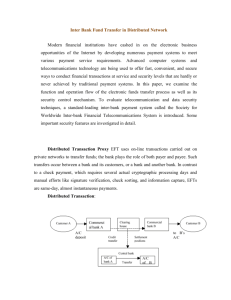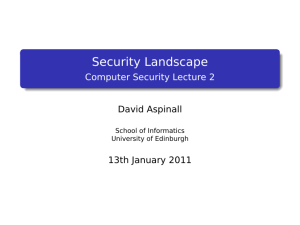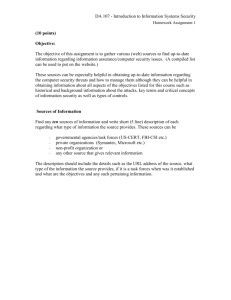CSC 421 COURSE COMPACT
advertisement
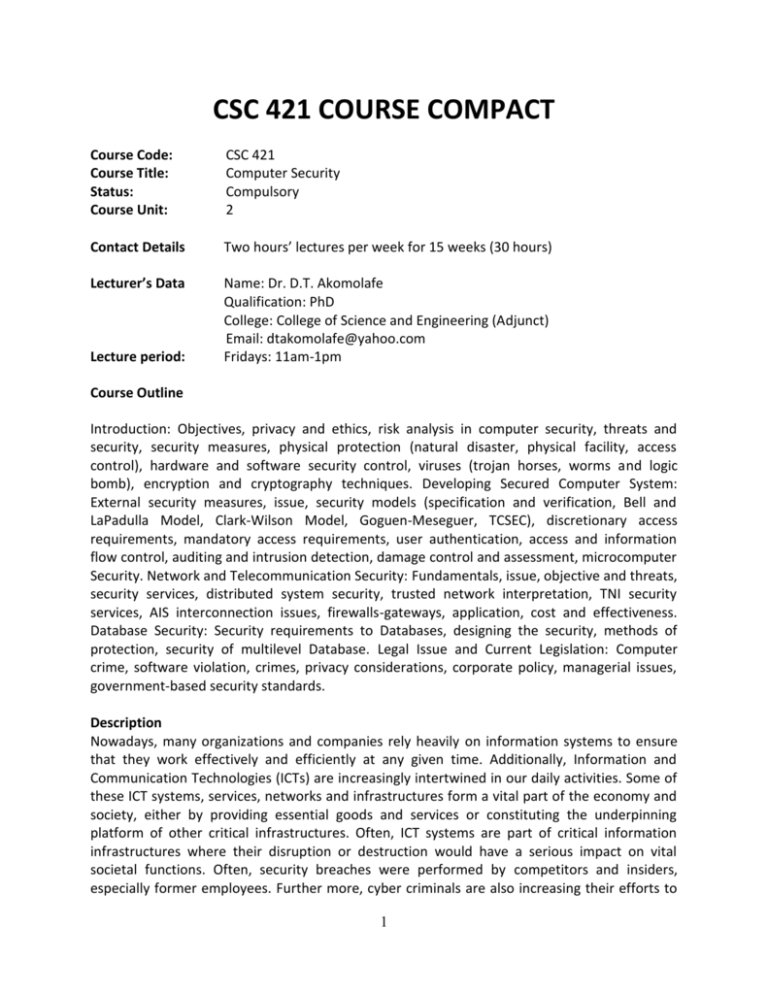
CSC 421 COURSE COMPACT Course Code: Course Title: Status: Course Unit: CSC 421 Computer Security Compulsory 2 Contact Details Two hours’ lectures per week for 15 weeks (30 hours) Lecturer’s Data Name: Dr. D.T. Akomolafe Qualification: PhD College: College of Science and Engineering (Adjunct) Email: dtakomolafe@yahoo.com Fridays: 11am-1pm Lecture period: Course Outline Introduction: Objectives, privacy and ethics, risk analysis in computer security, threats and security, security measures, physical protection (natural disaster, physical facility, access control), hardware and software security control, viruses (trojan horses, worms and logic bomb), encryption and cryptography techniques. Developing Secured Computer System: External security measures, issue, security models (specification and verification, Bell and LaPadulla Model, Clark-Wilson Model, Goguen-Meseguer, TCSEC), discretionary access requirements, mandatory access requirements, user authentication, access and information flow control, auditing and intrusion detection, damage control and assessment, microcomputer Security. Network and Telecommunication Security: Fundamentals, issue, objective and threats, security services, distributed system security, trusted network interpretation, TNI security services, AIS interconnection issues, firewalls-gateways, application, cost and effectiveness. Database Security: Security requirements to Databases, designing the security, methods of protection, security of multilevel Database. Legal Issue and Current Legislation: Computer crime, software violation, crimes, privacy considerations, corporate policy, managerial issues, government-based security standards. Description Nowadays, many organizations and companies rely heavily on information systems to ensure that they work effectively and efficiently at any given time. Additionally, Information and Communication Technologies (ICTs) are increasingly intertwined in our daily activities. Some of these ICT systems, services, networks and infrastructures form a vital part of the economy and society, either by providing essential goods and services or constituting the underpinning platform of other critical infrastructures. Often, ICT systems are part of critical information infrastructures where their disruption or destruction would have a serious impact on vital societal functions. Often, security breaches were performed by competitors and insiders, especially former employees. Further more, cyber criminals are also increasing their efforts to 1 steal sensitive corporate data and information. Criminals are daily devising sophisticated means to take advantage of employees, new technologies and software vulnerabilities. Consequently, this course covers fundamental issues and first principles of security that are capable of making attacks impossible. The course will look at the security policies, models and mechanisms related to confidentiality, integrity, authentication, identification, and availability issues related to information.. Other topics covered include basics of cryptography (e.g., digital signatures), Developing Secured Computer System, and network security (e.g., intrusion detection and prevention), risk management, and secure design principles. It will also cover topics in network and telecommunication security and database security. Issues such as organizational security policy, legal and ethical issues in security, standards and methodologies for security evaluation and certification will also be covered. Justification Computer security is an emerging field of computer science and engineering with a concentration on the security issues in computer systems. Computer Security is gaining prominence due to an increase in criminal activity affecting computer systems. ICT systems are part of critical information infrastructures where their disruption or destruction would have a serious impact on corporate organizations. Their multiplier effects are better imagined than experienced.Also, with the advent of networks and expansion of cyber space, security and trust have become a central challenge in computation and in information systems.Security breaches can have dire consequences both in financial and societal terms, therefore, securing the systems is of utmost importance. This applies both to the containment of everyday risks such as the failure of individual components and to the prevention of malicious attacks from outside the systems. This course will provide an overview of the crucial concepts and techniques of securing our systems either as a standalone or in network Course Objectives By the end of this course, students will be able to: a. State the basic concepts in information security, including security policies, security models, and security mechanisms. b. Explain concepts related to applied cryptography, including plain-text, cipher-text, the four techniques for crypto-analysis, symmetric cryptography, asymmetric cryptography, digital signature, message authentication code, hash functions, and modes of encryption operations. c. Explain the concepts of malicious code, including virus, Trojan horse, and worms and common vulnerabilities in computer programs d. Outline the requirements and mechanisms for identification and authentication and discuss issues about password authentication, including dictionary attacks (password guessing attacks), password management policies, and one-time password mechanisms. 2 e. Compare security mechanisms for conventional operating systems, including memory, time, file, object protection requirements and techniques and protection in contemporary operating systems and identify the requirements for trusted operating systems f. Describe security requirements for database security, and describe techniques for ensuring database reliability and integrity, secrecy, inference control, and multi-level databases. g. Describe threats to networks, and explain techniques for ensuring network security, including encryption, authentication, firewalls, and intrusion detection. Prerequisites Basic knowledge of operating systems, data structures, database systems and networks. Course Delivery Method Lectures, individual assignments and group presentation Evaluation Components Students must attend classes regularly and punctually too, read the assigned reading before class and participate in class discussions and presentations. The course will be graded as follows at the end of semester. o o o o 10% Group presentations, 5%class participation and attendance 15% Continuous Assessments 70% Final Exam Week 1-2 Security Basics Objectives Present general overview of computer security Understand some basic definitions and some related terms Week 3-5 Threats and security, 3 Objectives Explain threats, disasters and the component of threats Identify and explain security measures Discuss hardware and software protections Week 6 Continuous assessment Test Objective To test student knowledge on what they have been taught so far Week 7-9 Basic Cryptography and Network security Objectives Explain authentication, protocols and key management Discuss and illustrate encryption and cryptography technique Week 10 Presentations Objective To test students’ knowledge on some basic concepts and principles of Security Week 11-13 Developing Secured Computer System Objectives Discuss design principles Explain Security Mechanisms Understand the concept of Auditing Systems Explain Risk analysis Get used to System verification and evaluation 4 Week 14 – 15 Network and Telecommunication Security Objectives Identify and explain Network threats such as eavesdropping, spoofing, modification, denial of service attacks Explain network security techniques: firewalls Discuss Intrusion Detection and Response Text books i. Charlie Kaufman, Radia Perlman and Mike Speciner, Network Security (Prentice Hall 2002, 2nd ed.) ii. ColinBoyd and Anish Mathuria, Protocolsfor Authentication and Key Establishment(Springer 2003) iii. Charles P. Pfleeger and Shari L. Pfleeger. Security in Computing (3rd edition). PrenticeHall.2003. iv. Computer Security: Art and Scienceby Matt Bishop (ISBN: 0-201-44099-7), AddisonWesley 2003 5




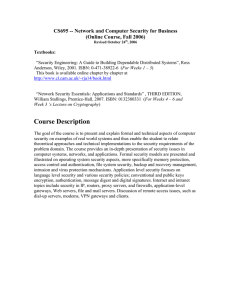
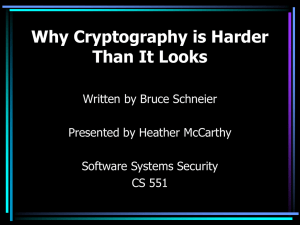
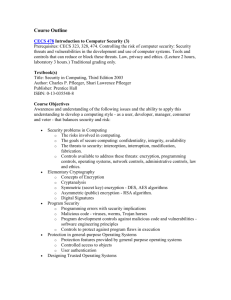
![Systems Assurance [Opens in New Window]](http://s3.studylib.net/store/data/007522633_2-e364c8f93e26286779d02c826b323ed6-300x300.png)
